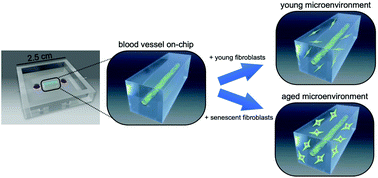A 3D tissue model-on-a-chip for studying the effects of human senescent fibroblasts on blood vessels†
Abstract
All human tissues experience aging that eventually causes organ dysfunction and disease. Cellular senescence was discovered in fibroblasts cultured in vitro. In adults, it is a primary defense mechanism against cancer, but also a major contributor to lifespan limits and disorders associated with aging. To assess how human blood vessels change in an aged environment, we developed an elementary tissue model-on-a-chip that comprises an in vitro three-dimensional model of a blood vessel embedded in a collagen gel with young or senescent skin fibroblasts. We found that senescent fibroblasts mechanically altered the surrounding extracellular matrix by exerting excessive traction stress. We then found that senescent fibroblasts induced sprouting angiogenesis of a microvessel via their senescence-associated secretory phenotype (SASP). Finally, we gathered evidence that the mechanical changes of the microenvironment play a role in sustaining SASP-induced angiogenesis. The model proved useful in monitoring morphological changes in blood vessels induced by senescent fibroblasts while controlling the proportion of senescent cells, and enabled the study of SASP inhibitors, a class of drugs useful in aging and cancer research.



 Please wait while we load your content...
Please wait while we load your content...